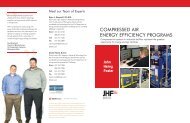The Turbo Air® 3000 Centrifugal Compressor Compressor Handbook
The Turbo Air® 3000 Centrifugal Compressor Compressor Handbook
The Turbo Air® 3000 Centrifugal Compressor Compressor Handbook
You also want an ePaper? Increase the reach of your titles
YUMPU automatically turns print PDFs into web optimized ePapers that Google loves.
Maintenance<br />
Discharge Air Check Valve Inspection<br />
At 6 month intervals, use the following procedure to inspect the discharge air check valve to determine<br />
whether it is still in good working order or whether it must be replaced.<br />
1. Shut down the compressor and lockout the main motor starter.<br />
2. Close the system block valve and exhaust any pressure in the check valve line.<br />
3. Remove the check valve from the piping.<br />
4. Remove both plugs and the hinge pin, and then inspect the hinge pin, disc, and seat for wear.<br />
5. If any parts are worn or damaged, replace the valve.<br />
— or —<br />
If wear is not apparent, clean, reassemble, and reinstall the valve, being sure that the valve disc<br />
operates freely.<br />
6. To verify correct orientation of the discharge air check valve, use the following criteria:<br />
· <strong>The</strong> check valve should be located downstream of the blow-off valve and upstream of the<br />
system block valve.<br />
· <strong>The</strong> arrow should be pointing in the direction of flow (away from the compressor).<br />
· For horizontal installation (the recommended position) the hinge pin must be above the<br />
centerline, which is assured when the metal label can be seen from the top of the valve.<br />
WARNING:<br />
When installing a new discharge check valve or reinstalling a valve, always be certain of<br />
proper orientation. Incorrect orientation will cause equipment damage.<br />
5—23



